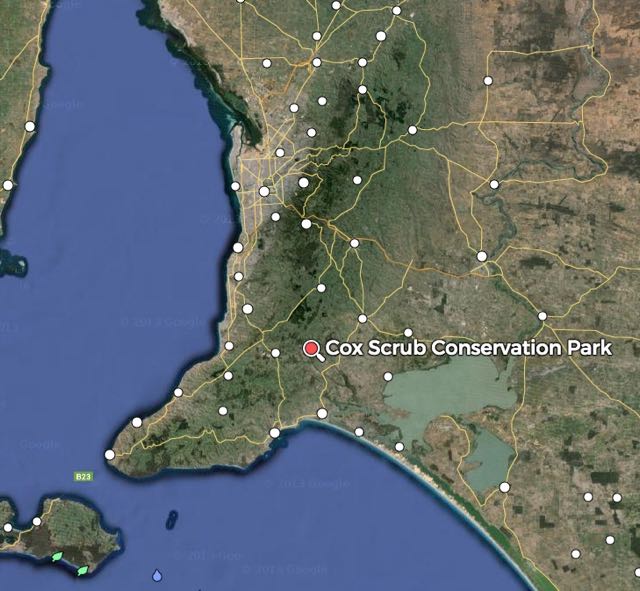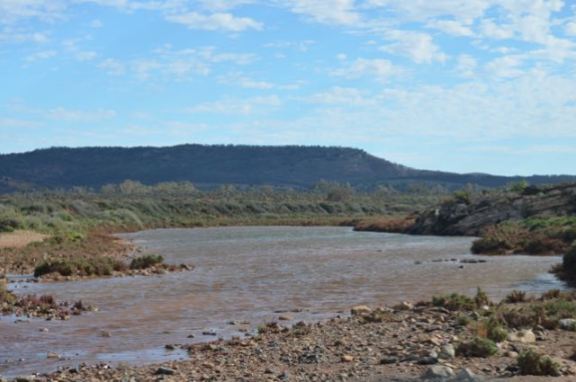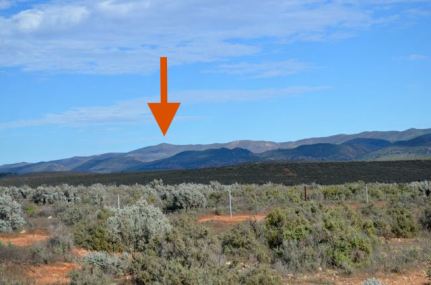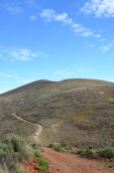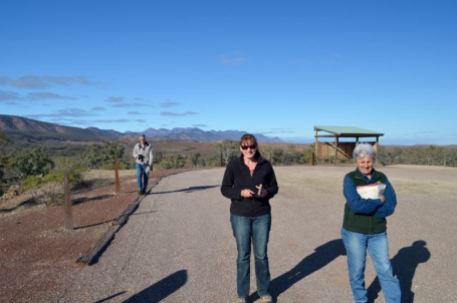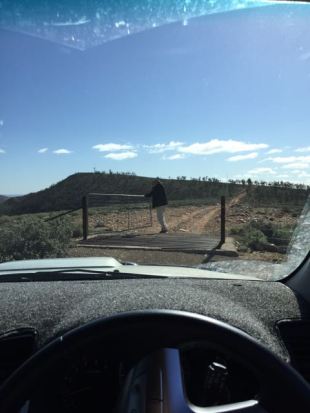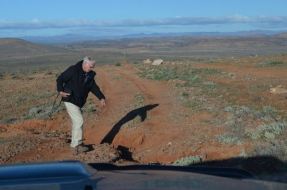After leaving the Kyeema Conservation Park I headed for my second activation, the Cox Scrub Conservation Park, VKFF-824, which is located about 70 km south of Adelaide on the Fleurieu Peninsula.
Above:- Map showing the location of the park. Map courtesy of mapcarta.com
This was to be a unique WWFF park for me. Although I have activated the park a number of times previously as part of the VK5 Parks award. For more detailed information on the park, and thiose activations, please have a look at my previous posts…..
https://vk5pas.org/2013/12/27/cox-scrub-conservation-park/
https://vk5pas.org/2014/04/12/cox-scrub-conservation-park-2/
I headed for the main carpark off the Bull Creek Road. This is on the eastern side of the park, and is the location from where I have previously activated the park.
On my way to the park I had spoken with Col VK5HCF in the Penambol Conservation Park, VKFF-802 from my mobile. Col was keen to get me in the log for a park to park contact. And as I was pulling in to the park I gave Col another quick shout to let him know that I would be up on deck in about 10 minutes.
So after setting up, I immediately went to 7.105 and there was Col VK5HCF calling CQ from Penambol. Col was my first contact (5/9 both ways) and a park to park contact for the VK5 Parks Award to boot.
I then tuned down the band a little and heard Hugh VK5NHG calling CQ on 7.103 from SOTA peak, Eke Hill, VK5/ NE-069 near the Bendleby Ranges in the north of South Australia (5/9 both ways).
I kept tuning down the band and my next contact was with Brett VK4FTWO, in the Burrum Coast National Park, VKFF-070 (5/6 both ways).
I then went up to 7.095 and there worked Rob VK4FFAB who was also out and about, in the Venman Bushland National Park, VKFF-507. A mini pile up ensued after my contact with Rob, with callers from VK3, VK5, & VK7. This included QSO’s with Julie VK3FOWL & Joe VK3YSP operating portable at the Melbourne Museum, and Brandon VK4FABB who was activating VKFF-507 with Rob VK4FFAB. Following my QSO with Brandon, Ian VK1DI called in, operating portable from Percival Hill Nature Reserve, VKFF-859 in the ACT. For more information on Ian’s activation, check out Ian’s blog at…..
http://vk1di.blogspot.com.au/2015/06/percival-hill-nature-reserve-vkff-859.html
And a number of contacts later, Nick VK3ANL called in again, this time on the top of Mount Donna Buang, VK3/ VC-002 and within the Yarra Ranges National Park VKFF-556.
I worked a total of 45 stations on 40m, before trying 20m. But the 20m band was very quiet. I had left my run there a little late. I only managed three contacts, however one of those was with Mike VK6MB who was activating Karijini National Park, VKFF-237, followed by John VK6NU. It is always good to get the VK6 guys in the log.
I also had a visitor during this activation. It was Phil VK5GM, who I had worked from Kyeema. Phil lives nearby at Tooperang, so He decided to pop in and say hello and have a look at my portable set up.
It was getting dark and was nearly 5.30 p.m. so it was time to pack up and head back home to Mount Barker. This was another successful activation for me, with a total of 48 contacts, and a new VKFF park to add to my Activator list.
The following stations were worked on 40m SSB:-
- VK5HCF/p (Penambol CP VKFF-812)
- VK5NHG/p (SOTA VK5
- VK4FTWO/p (Burrum Coast National Park, VKFF-070)
- VK4FFAB/p (VKFF-507)
- VK5ZGY/m
- VK3PMG
- VK3FOWL/p (Melbourne Museum)
- VK3FQSO
- VK3BHR
- VK4FABB/p (VKFF-507)
- VK1DI/p (Percival Hill Nature Reserve, VKFF-859)
- VK3YSP/p (Melbourne Museum)
- VK3NBL/p
- VK4AAC/5
- VK3ARM/m
- VK3DBP
- VK3TJK
- VK3NBV
- VK3YAR
- VK5FTRG
- VK7LCW
- VK5FMID
- VK3OF
- VK5ZAR
- VK3PF
- VK5GJ
- VK5KX
- VK5TR
- VK5NRG
- VK5HV
- VK5GM
- VK3FLES
- VK5SFA
- VK2LEE
- VK3TKK/m
- VK5KBM
- VK4FBMW
- VK3ANL/p (SOTA VK3/ VC-002)
- VK5FANA
- VK2MJB
- VK3LO
- VK5HEL
- VK3DCU
- VK5ZEA
- VK2LAX
The following stations were worked on 20m SSB:-
- VK5GJ
- VK6MB/p (VKFF-257)
- VK6NU

